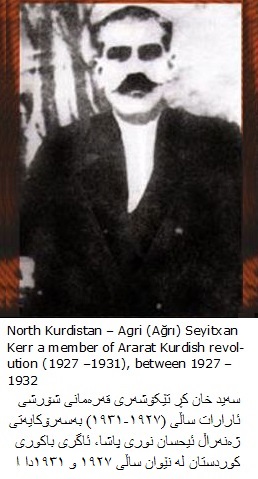Kurdish republic of AGRI
Reşo (Reşokê Silo)

The Kurdish hero Reşo (Reşokê Silo) was killed by a shot in his mouth and behead
in his wife's village in the winter of 1931. In the same period the killed the
Turkish army residents Esirler, mıhemedê xalıt, emerê Xalite, keremm Fethiye
Silo, the zilan village was circulated. Silo Reşo was also fighters in the
Sheikh Said Piran revolution in Western Anatolia in 1925.
Sheikh Said was
executed in 29 July 1925 by the Turkish ataturk goverment and Silo Reşo escaped
to xile in 1926 en he was returns to North Kurdistan mountain with his friends
Qulîxan Bakr Pain & Seyitxane Kerr. Seyit was one of the important pillars of
revaluation of Sheikh Said Piran, the Sheikh Said death & Zilan massacre in 1928
effects both Seyitxan & Alican. Both the aggression of Turkish government
against Sheikh Said Piran revolution effects both and reactions accumulation in
1930 as response in in the village a major revolt began.
Seyit Xané Ker

Seyitxane Kerr was born in the village Qıcıx in Mus Provence connected to the
center of the Seyitx seyide Hasek, was the tribal arm is
known
as Seydou Usıvé Mala. His brother joined the rebellion with Tevfik. He had
hearing problems (deafness) known as Seyit Xané Ker (deaf Seyitxan).
Alican tribes a brother Abdul Hamid and Feyzullah Beraza be recognized as
belonging to the Mala Bişar. Originally from the village in the district of
Erzurum Hespreş. The in the village 45 men collects in the landscape of Ali
Campbell brothers Abdul Hamid and Fezullah to join the rest to help the rebels
Zeylan Alican to
fight the Turks. The men were
merged with Seyit xan fighters in that area first their power were 75 men
were later more than a hundred.
The Turkish gendarmes were sent to the region for four months with very tough
conflict, many of Turkish gendarme and Kurdish fighters lost their lives in that
conflict. The weakening of fight caused the Alican to break and end the
fourth month conflict considering the surrender and reported it to the opposite
side. However, realization of revolution purpose end in 1931, he was shot from
behindin his back. Some have said the killed by gendarmes, and some said
accidentally by one of his owen men. The Haskovo town is in district
Muş
the shooting location (the vartınis village) there he is buried. Feyzullah
brothers, Abdul Hamid was getting the financing from feqi sıléman near Erzurum
Karayazı a few days later near that place he was slain and decapitated the
authorities have exhibited him to the Kurdish population there.
Alican and after the killing of his brother's side through Seyit Xan remaining
men continued to clash. Seyitx wanted to finish the job that he had started.
Kağızman, Karaköse and Doğubeyazit is returned to the garrison of the Cavalry
Regiment, 17th Mobile Gendarmerie regiment had been dispatched to the region
under the command of Colonel Rifat Bey.
Seyit Xan returns to the mountains swear by Quran to continue the conflict en he
organized the attack to the troops and the gendarmerie, the majority of them
lost their life against the gendarmerie regiment and some of them have managed
to escape to the mountains again,
Especially those in command of Sayyid Rasul succeeded in leading them in the
direction of Beyazit. In the same siege şemıkanl Temur Çelxo conflict he managed
with his brother to Iran. However, the ongoing conflict in one of these raids
that Seyitxan ambushed by the police in 1932 along with his men lost their
lives.
Aziza's the Bedirxan pasha's grandson Kadri Cemil Pasha memoirs about Seyitxan
and especially Mus mountains and Manzikert in the vicinity and the large Turkish
gendarmerie intensive attacks against North Kurdistan. Seyitxan has inflicted
Turkish gendarmerie lots of damage.
The Zilan Massacre (Geliyê Zîlan)

Wene (Van) in
North Kurdistan this photo was taking 1930 after it declared
independent on their own lands Katlimami Kurds (Kurdish republic of AGRI).
The Zilan Massacre refers to the massacre of thousands of Kurdish residents in
the Zilan Valley of North Kurdistan by 12/13 July 1930, during the Ararat
rebellion, in which 800–1500 armed men participated.
The Zilan Massacre took place in the Zilan or Zeylan valley in
Kurdish (Geliyê Zîlan), located to the north of the town of Erciş in Van
Province. The massacre took place in July 1930, before the third Ararat
Operation in September 7–14, 1930, which was a military operation of the
Turkish IX Corpsunder the command of Ferik (Lieutenant General) Salih
(Omurtak) against Mount Ararat. The number of people killed in the massacre
varies according to different sources. According to the daily
newspaper Cumhuriyet (July 16, 1930), about 15,000 people died. The account
of Hesen Hîşyar Serdî (1907 – September 14, 1985), a writer and participant in
the Ararat rebellion, states that 47,000 villagers from 18 villages of Ademan,
Sipkan, Zilan and Hesenan tribes were killed. Armenian researcher Garo
Sasunistates that 5,000 women, children and the elderly were massacred. Finally,
according toBerliner Tageblatt, the Turks in the area of Zilan destroyed 220
villages and massacred 4,500 women and the elderly. Today Ozbek from Asia in the
Kurdish villages placed.


